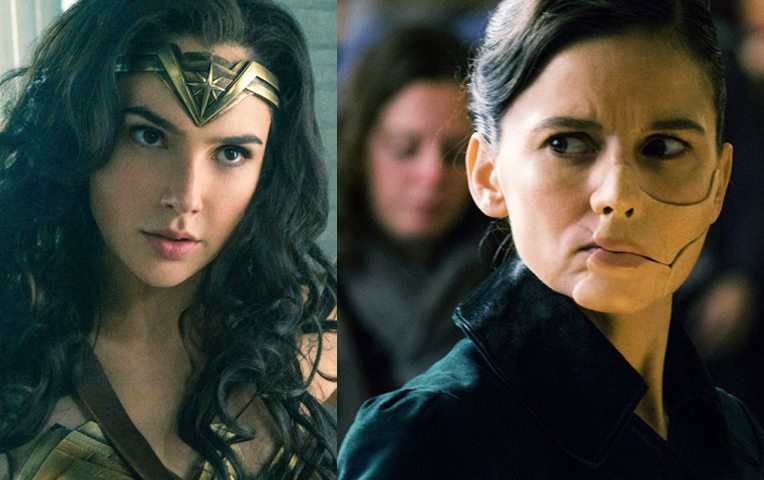Most movies that feature skin disease use it to represent evil.

The summer of 2017 heralds the release of "Wonder Woman." Gal Gadot imbues the role with strength, empathy and...clear skin. Her female evil counterpart is a German bioterror expert. Not only is she morally corrupt, she is epidermally deformed. Her mask covers significant facial scarring.

The cinematic concept that a clear complexion is good and scarring is evil is not new. In the 1986 Oliver Stone film "Platoon", there is an ongoing rivalry between two soldiers. Willem Dafoe is morally pure in the film, reflected by his non-traumatized skin.

His rival is portrayed with sinister skill by Tom Berenger. Also skillful? The makeup artists that applied prosthetically created scarring. Since movies are visual, there is nothing like a defective peel to tell an audience that a character is a bad apple, with a not-so-healthy core.

Can this be the dawn of Skinema? In 1910, Thomas Edison's studio released a 16 minute short, the first movie adaptation of Frankenstein. Scary guy, in desperate need of a makeover. Of all skin conditions seen in movies, scars are by far the most prevalent.

Check out the surgical work by Dr. Frankenstein, from the classic 1931 Boris Karloff version. To this day, facial surgeons have to reassure patients that skin cancer removal by a well trained physician usually does not lead to monstrous scars, stitch marks, and metal neck bolts. Post surgical patients can expect attractive results rather than Gothic horror.

Another early example is this scarred gangster to the right in "The Musketeers of Pig Alley." When this black and white silent film was released in 1912, villains with facial imperfection were already becoming a stock cinematic symbol. Scars have been extensively used because they are easy to replicate with makeup. They also suggest a violent past with a quick glance.

Got scars? "Freddy" from "A Nightmare on Elm Street" does--extensive burn scars. In the real world, burn victims are not morally scarred.

In 2007, when Quentin Tarantino released "Death Proof," he cast Kurt Russell as Stuntman Mike. A true jerk, he uses his car as a serial killing tool. Prior to this release, Russell usually played heroes. A facial scar shows that Mike's car is not the film's only tool.

In the Bond film, "Goldeneye," James is paired with fellow agent 006, played by Sean Bean. Initially, he fights alongside Bond. Explosions occur (it is a Bond movie, after all), and 006 gets 00-scarred. In true movie logic, he becomes evil. Interestingly, Bean himself has mild facial scarring visible in all of this other roles.

Many children's films feature examples of pernicious characters with problem skin. The Disney flick "The Lion King" stars Jeremy Irons as the voice of the merciless villain who is named after his "Scar" (seen across his eye). As one of the most popular home video releases in the United States, one wonders how many children subconsciously equate scars with evil.

Ah, the 1950's. Things were so simple then. Good kids were your pals, and if they weren't you would race hot rods in the LA canals, beat 'em, and then stage an entire musical number. In "Grease," John Travolta plays the rare teen with a complexion as clear as the windshield of a new Thunderbird. Even his pomade-pumped hairdo didn't cause a breakout. His archenemy wasn't quite so lucky. Actor Dennis Stewart plays "Leo," tenderly called "Crater Face," a fierce fella who cackles until he realizes that acne scarring is no easy fix. In the 1950's, doctors occasionally turned to radiation therapy to treat bad acne. In retrospect, this greatly increased patients risk of skin cancer. Fortunately, medicine has come a long way for acne treatments, but not necessarily for acne scars.

How about the daddy of all facial deformities? As in the "Luke, I am your father" kind of daddy. In the cinematic tradition of the Phantom of the Opera, Darth Vader remains the quintessential scarred villain. He is concealed by his mask in The New Hope, and shown to be scarred from behind in The Empire Strikes Back. By the end of The Return of the Jedi, Vader's scars are fully seen as his character becomes more sympathetic. A long time ago, far, far away, there weren't many treatment options for scarring. These days, scars can be lessened by surgery, laser treatments, chemical peels, and cortisone injections.
Next »
















